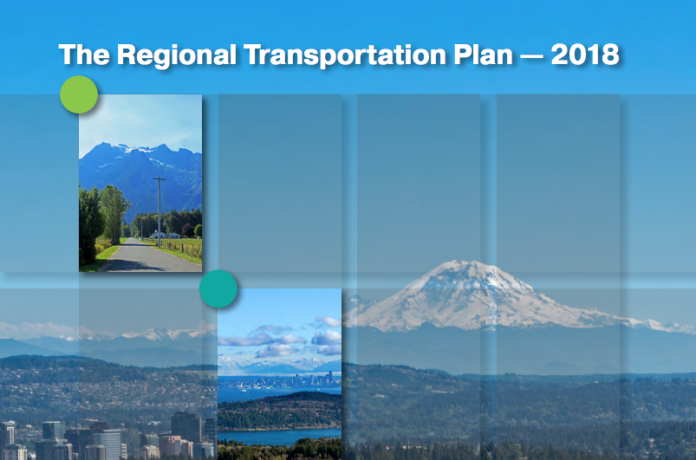The Puget Sound Regional Council (PSRC) is updating the four-county region’s long-range transportation. Dubbed as “The Regional Transportation Plan — 2018,” the plan makes key regional investments. The plan runs through 2040 and assumes that the population of the Seattle metropolitan area will grow by another one million residents and that 800,000 new jobs will be created in King, Pierce, Snohomish, and Kitsap counties. Travel demand in the region is anticipated to rise another 30%, which would necessitate targeted, high-capacity investments to support such robust growth. A 45-day comment period on the draft plan is open through the end of the month. In the spring, policymakers will approve a final version.
The Right Plan
The Seattle Times Editorial Board recently criticized the plan in an article entitled “New Regional Transportation Plan Must Put Pragmatism Over Ideology.” True to form, the editorial board was way off the mark with its opening salvo. “If you like how Seattle plans for traffic congestion, you’ll love the new regional transportation plan that the Puget Sound Regional Council is developing,” the editorial board whinged. The piece from there devolved into complaints over managing demand, data, and timing of the plan.
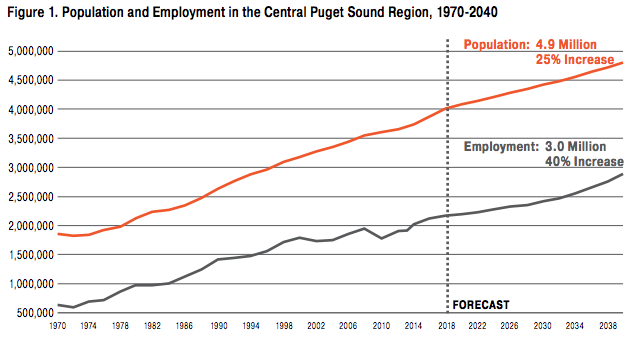
The truth is, the long-range plan will fund massive road and highway expansions while also employing smart technology to enhance system capacity. The plan will also make wise investments in high-quality transit corridors and key multi-use trails that can move commuters and recreationists alike. Designed to support the “VISION 2040” regional growth plan, the transportation plan would connect Puget Sound communities to regional growth centers, manufacturing and industrial centers, and subregional centers. The plan also places an emphasis on investing in growing transit-oriented communities.
In sum, the basic philosophy of the plan to give people options across modal types. Implementing the plan policies will deliver the biggest bang for the buck while meeting other objectives such as fostering compact and healthy communities, reducing carbon emissions, and providing equitable access to opportunity. As a steward of taxpayer money, it’s the right approach for a regional planning agency strapped for federal funds.
Summary of Key Investments
While the Seattle Times Editorial Board would have you think the plan is a sham, the plan would help fund $105.2 billion in maintenance, preservation, and operations of the transportation system through 2040 before even putting a dime in for new infrastructure. Tens of billions more would be focused on expanding and building new highways and transit systems. PSRC has put together a succinct summary highlighting key investments by county. The following diagrams provide a useful window into understanding the planned investments, though one can also peruse an online interactive map or full project list for more detail.
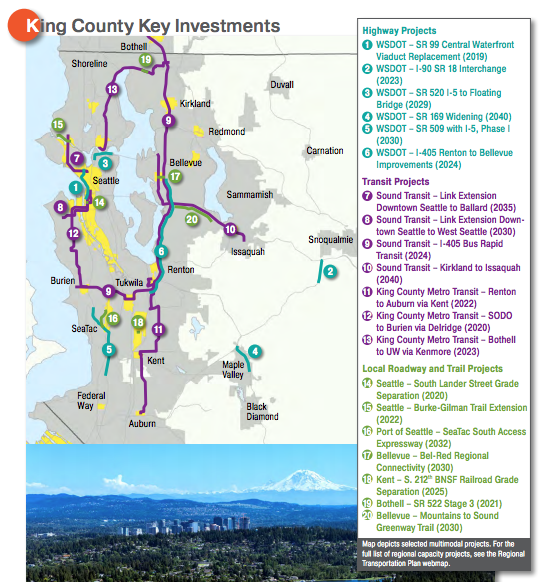
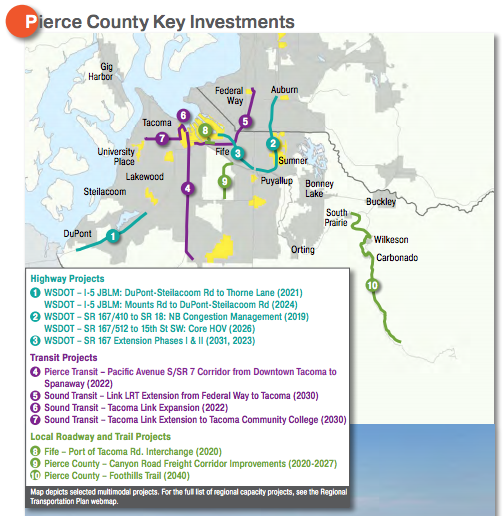
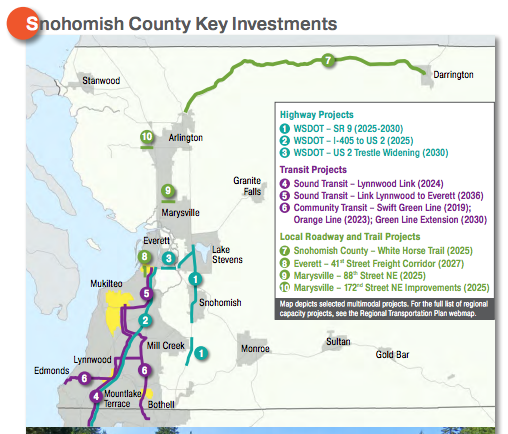
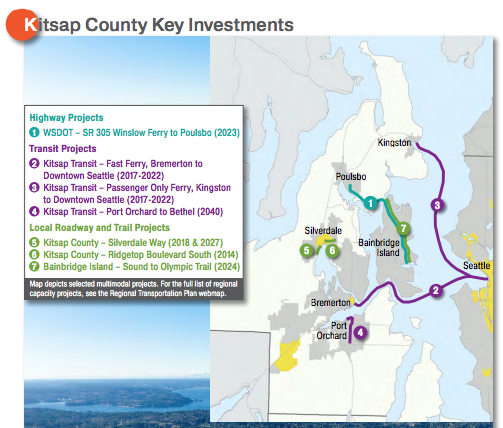
Notable Transit and Non-Motorized Investments
The key highway and road projects speak for themselves, but it’s worth walking through the myriad investments in transit and non-motorized facilities that the plan would help realize. The project costs shown are total estimated project costs (noted in parentheses and italicized), not necessarily the amount pass-through grants that the PSRC would provide to facilitate planning and construction. Year of completion is also highlighted (noted in parentheses and bolded).
Regional Transit Projects
The PSRC’s transportation plan would embrace Sound Transit 3 light rail expansions, including: Downtown Redmond (2023, $1.2 billion), Federal Way to Tacoma (2030, $2.3 billion), West Seattle to Downtown Seattle (2030, $1.8 billion), Ballard to Downtown Seattle (2035, $2.9 billion), a new Downtown light rail tunnel (2035, $2.0 billion), Lynnwood to Everett (2036, $3.5 billion), Tacoma Community College (2039, $551.1 million), and Kirkland to Issaquah (2040, $2.2 billion). Infill stations could also be funded and as a carryover, the transportation plan will fund programmed expansions under Sound Transit 2 like East Link, Lynnwood Link, and Tacoma Link. Other major components of Sound Transit 3 would be partially funded by the PSRC, such as the rollout of I-405 BRT (2024, $1.0 billion) and South Sounder capital improvements, including an extension to DuPont (2036, $1.1 billion). Note all costs in parentheses are estimated total costs rather than PSRC portions.
King County and Seattle Transit Projects
A variety of new RapidRide corridors will be completed in the years ahead. In the early years of the plan, these corridors will connect the following communities:
- Downton Seattle to Burien via Delridge (2020, $67.1 million);
- Redmond Overlake to Renton via Eastgate and Newcastle (2021, $90.3 million);
- Renton to Auburn via Kent (2022, $64.2 million);
- Highline Community College to Green River Community College via Kent (2023, $46.3 million);
- Bothell to University of Washington via Kenmore (2023, $55.2 million);
- Federal Way (Twin Lakes) to Lea Hill via Auburn (2024, $53.6 million);
- Totem Lake to Eastgate via Kirkland (2024, $49.9 million); and
- Renton Highlands to Rainier Beach Station via Downtown Renton (2026, $46.1 million).
Later years of the transportation plan will unleash another eight RapidRide corridors:
- Federal Way (Twin Lakes) to Kent via Star Lake (2040, $50.2 million);
- University District to Othello Station via Capitol Hill and Beacon Hill (2040, $41.9 million);
- East Redmond to Downtown Kirkland (2040, $29.3 million);
- Loyal Heights to University of Washington Station (2040, $25.1 million);
- Kenmore to Redmond Overlake via Totem Lake (2040, $67.0 million);
- Sand Point to Downtown Seattle via Greenlake (2040, $46.1 million);
- Alki to Burien (2040, $50.3 million);
- Interbay to Madison Park via Capitol Hill and South Lake Union (2040, $33.5 million).
In addition to the RapidRide corridors sponsored by Metro, Seattle will also receive funding for existing and planned in-city RapidRide corridors. Notable bus priority corridor projects pegged for Seattle that won’t necessarily receive the RapidRide treatment include the Pike/Pine corridor (2025, $14.5 million), Denny Way corridor (2025, $42.6 million), Lake City corridor (2030, $5.3 million), Jefferson/Yesler corridor (2030, $17.4 million), Greenwood corridor (2030, $9.9 million), Queen Anne loop (2035, $29.8 million), Crown Hill corridor (2035, $60.7 million), and Othello corridor (2035, $21.3 million). Streetcar projects in Seattle will get some funding, too, including a First Avenue extension to Seattle Center (2035, $102.0 million).
Transit Projects in Other Counties
Key transit-related projects in Pierce County include:
- SR-7/Pacific Avenue BRT between Downtown Tacoma and Spanaway (2022, $154.7 million);
- A new transit line in Spanaway (2022, $25.8 million);
- Lakewood-Tacoma BRT via South Tacoma will open by (2026, $58.2 million);
- Puyallup-South Hill BRT (2030, $41.2 million);
- A new transit center in South Hill (2030, $15.5 million); and
- Lakewood-Tacoma BRT via University Place (2030, $6.1 million).
Key transit-related projects in Snohomish County include:
- Swift Green Line BRT (2019, $75.9 million);
- Swift Orange Line BRT (2023, $87.5 million);
- Evergreen Way (SR-99) transit lanes between 115th St SW and 46th St SE (2023, $2.0 million);
- Everett-Arlington BRT (2026, $61.2 million);
- A new transit center for Smokey Point (2030, $2.3 million);
- Swift Green Line BRT extension to UW-Bothell (2030, $7.6 million); and
- Seaway Transit Center-Cathcart BRT (2030, $57.5 million).
Key transit-related projects in Kitsap County include:
- A passenger-only ferry will connect Kingston and Seattle (2022, $10.0 million);
- A passenger-only ferry will connect Southworth and Seattle (2023, $16.6 million);
- A new transit center in Silverdale (2025, $12.0 million);
- A BRT line between Poulsbo and Bainbridge Island ferry dock (2030, $12.3 million);
- SR-303 access and transit lanes in Bremerton (2032, $158.2 million); and
- A BRT line between Port Orchard and Bethel (2040, $17.0 million).
Key Trails and Multi-Use Path Projects
The transportation plan would provide substantial contributions to many regional trails and multi-use paths throughout the region. Often, these trails connect densely populated areas and can provide direct access to jobs and housing. In other cases further out, the trails are more geared toward recreation, an equally valuable objective. In King County, several trail and multi-use path projects would be partially funded by the transportation plan, including:
- The Missing Link connection for the Burke-Gilman Trail in Ballard will be completed (2022, $21.5 million);
- The Redmond Central Connector will be constructed in Downtown Redmond and run north to NE 124th St (2024, $39.7 million);
- The Green-to-Cedar Rivers Trail will be built between Maple Valley and an area southeast of Black Diamond (2025, $47.4 million);
- The Interurban Trail between Tukwila and Pacific will be substantially upgraded (2026, $61.9 million);
- An Auburn-Snoqualmie trail will be constructed along SR-18 (2030, $104.2 million);
- The Eastside Rail Corridor Trail will connect communities between Woodinville and Renton (2030, $146.4 million);
- The Cedar-Sammamish Trail will link Renton and Issaquah (2032, $23.3 million);
- The Cross Kirkland Corridor will link South Kirkland to Eastgate (2037, $60.5 million); and
- The Green River Trail will be improved in three phases from Kent to the end of the Green-to-Cedar Rivers Trail (2025-2040, $75.0 million).
In Kitsap County, only one key trail will be constructed. The Sound to Olympics Trail will be fully constructed on Bainbridge Island adjacent to SR-305 (2024, $18 million). Snohomish County is also only slated to get one trail extension funded by the transportation plan, that being the Centennial Trail. The will be extended in two segments: Snohomish to Monroe (2025, $32.6 million) and south of Monroe toward Duvall (2025, $35.5 million). Pierce County would receive larger investments in trails, including:
- A new Schuster Parkway Promenade that will add a multi-use path along Tacoma’s waterfront (2023, $21.3 million);
- A 44-mile trail between Tacoma and Elbe known as “Trail To The Mountain” (2040, $106.5 million); and
- The Pipeline Trail between Tacoma and Orting (2040, $49.0 million).
Opportunity for Input
The comment period on the transportation plan is soon to end. Those who have feedback on the project capacity priority list or the principles of the plan should get comments in by January 31st.
Stephen is a professional urban planner in Puget Sound with a passion for sustainable, livable, and diverse cities. He is especially interested in how policies, regulations, and programs can promote positive outcomes for communities. With stints in great cities like Bellingham and Cork, Stephen currently lives in Seattle. He primarily covers land use and transportation issues and has been with The Urbanist since 2014.


